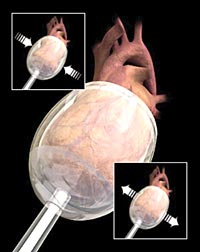Government grants company $1.4 million to further develop VAD
The Myo-VAD cardiac support system does not come into direct contact with circulating blood.
Click Here to Manage Email Alerts
The U.S. government allocated $1.4 million to Biophan Technologies Inc. to develop its Myo-VAD cardiac support system.
Myo-VAD is based on direct mechanical ventricular actuation. It is a flexible polymer cup that fits around the heart and is attached to a drive unit that restores blood flow by pumping the heart, according to a company release.
Biophan expects to finish human trials by the end of 2008 and to submit its research to the FDA for approval in 2009.
Current ventricular assist devices typically provide systolic support for the left ventricle; however, the Myo-VAD system provides both systolic and diastolic support, according to Jeff Helfer, president of the cardiology division and vice president of engineering at Biophan.
The House of Representatives approved $1 million for the device in the 2007 Department of Defense Appropriations Bill, and the Senate approved an additional $400,000.
Fewer complications
|
Courtesy of Biophan |
The Myo-VAD does not come into direct contact with blood, which could eliminate serious or fatal complications such as bleeding, clotting and stroke, or infection.
Mark P. Anstadt, MD, installed an earlier version of the technology in five people under emergency-use criteria at Duke University Medical Center, Helfer said. The device was installed for 2.5 to 7.5 days in most patients; however, the maximum number of days the device remained installed was 84.
Helfer said the device symbolizes a “paradigm shift in devices,” because the Myo-VAD could be a safer and more effective treatment in the short term and the long term. It has the potential to remain in the patient for more time with fewer complications than other VADs, which helps the heart recover. Rapidly delivered short-term support helps minimize ischemic damage in patients suffering from acute HF. Although this device is used short-term, Helfer said the second-generation device will be used for up to one year.
In addition, Myo-VAD is easily inserted and removed, so researchers anticipate lower complication rates and lower total procedure cost. Although existing VADs require a specialized surgeon to perform a sternotomy, a general surgeon performing a thoracotomy will be able to install the Myo-VAD, Helfer said in an interview with Cardiology Today.
“We provide the potential to help damaged hearts work again,” Mike Weiner, chief executive officer of Biophan, said.
Biophan hopes to reach the underserved population of women with heart disease, according to Helfer. Current products are bigger than the Myo-VAD and seem designed better for men, he said. Women commonly present diastolically and current VADs treat systolic failure, he said. Women will also benefit from the technology because it is associated with fewer complications, Helfer said. dDta show that women do not tolerate VAD-related complications as well as men. – by Lauren Riley

